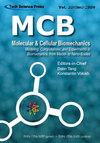Fully-Coupled Fluid-Structure Interaction (FSI) Simulations of Heart Valve-Left Ventricle Dynamics
Q4 Biochemistry, Genetics and Molecular Biology
引用次数: 0
Abstract
Fluid–structure interaction (FSI) is a common phenomenon in biological systems. FSI problems of practical interest, such as fish/mammalian swimming, insect/bird flight, and human cardiac blood flow and respiration often involve multiple 3D immersed bodies with complex geometries undergoing very large structural displacements, and inducing very complex flow phenomena. Simulation of heart valve FSI is a technically challenging problem due to the large deformation of the valve leaflets through the cardiac fluid domain in the atrium and ventricular chambers. Recently, we developed a FSI computational framework [1] for modeling patient-specific left heart (LH) dynamics using smoothed particle hydrodynamics (SPH) for the blood flow, and non-linear anisotropic finite element analysis for heart valve tissues. SPH is a meshless, statistical method that relies on sampling neighboring particles to calculate fluid field variables. SPH’s mesh-free and Lagrangian nature makes it particular suitable for numerical problems where there are 1) moving boundaries and 2) large deformations, which are the conditions seen in heart valve FSI applications. In this presentation, I will explain under which scenarios that heart valve FSI simulations are needed, and give a few examples of our FSI applications. Briefly, we utilized the SPH-FE based, fully-coupled FSI modeling techniques to investigate the pathological LH dynamics under primary and secondary mitral regurgitation (MR) conditions [2], and examine the underlying biomechanics of various minimally-invasive mitral valve (MV) repair techniques. The FSI model was also used to investigate the impact of transcatheter aortic valve replacement (TAVR) on LH dynamics under bicuspid aortic valve (BAV) stenosis and concomitant significant MR [3].心脏瓣膜-左心室动力学的完全耦合流固耦合(FSI)模拟
流固相互作用(FSI)是生物系统中常见的现象。具有实际意义的FSI问题,如鱼类/哺乳动物游泳、昆虫/鸟类飞行和人类心脏血液流动和呼吸,通常涉及多个具有复杂几何形状的3D浸入体,经历非常大的结构位移,并诱发非常复杂的流动现象。由于瓣膜小叶通过心房和心室的心液域产生了很大的变形,因此心脏瓣膜FSI的模拟在技术上是一个具有挑战性的问题。最近,我们开发了一个FSI计算框架[1],利用光滑粒子流体动力学(SPH)对血流进行建模,并对心脏瓣膜组织进行非线性各向异性有限元分析。SPH是一种无网格的统计方法,它依赖于采样邻近粒子来计算流场变量。SPH的无网格和拉格朗日性质使其特别适合于存在1)移动边界和2)大变形的数值问题,这是在心脏瓣膜FSI应用中看到的条件。在这次演讲中,我将解释在哪些情况下需要心脏瓣膜FSI模拟,并给出我们的FSI应用的几个例子。简单地说,我们利用基于SPH-FE的全耦合FSI建模技术来研究原发性和继发性二尖瓣反流(MR)条件下的病理LH动力学[2],并检查各种微创二尖瓣(MV)修复技术的潜在生物力学。FSI模型还用于研究经导管主动脉瓣置换术(TAVR)对双尖瓣主动脉瓣(BAV)狭窄及伴随显著MR的LH动力学的影响[3]。
本文章由计算机程序翻译,如有差异,请以英文原文为准。
求助全文
约1分钟内获得全文
求助全文
来源期刊

Molecular & Cellular Biomechanics
CELL BIOLOGYENGINEERING, BIOMEDICAL&-ENGINEERING, BIOMEDICAL
CiteScore
1.70
自引率
0.00%
发文量
21
期刊介绍:
The field of biomechanics concerns with motion, deformation, and forces in biological systems. With the explosive progress in molecular biology, genomic engineering, bioimaging, and nanotechnology, there will be an ever-increasing generation of knowledge and information concerning the mechanobiology of genes, proteins, cells, tissues, and organs. Such information will bring new diagnostic tools, new therapeutic approaches, and new knowledge on ourselves and our interactions with our environment. It becomes apparent that biomechanics focusing on molecules, cells as well as tissues and organs is an important aspect of modern biomedical sciences. The aims of this journal are to facilitate the studies of the mechanics of biomolecules (including proteins, genes, cytoskeletons, etc.), cells (and their interactions with extracellular matrix), tissues and organs, the development of relevant advanced mathematical methods, and the discovery of biological secrets. As science concerns only with relative truth, we seek ideas that are state-of-the-art, which may be controversial, but stimulate and promote new ideas, new techniques, and new applications.
 求助内容:
求助内容: 应助结果提醒方式:
应助结果提醒方式:


